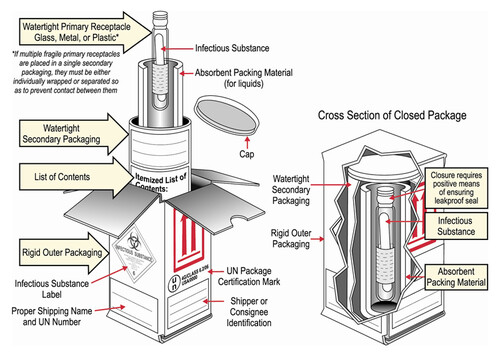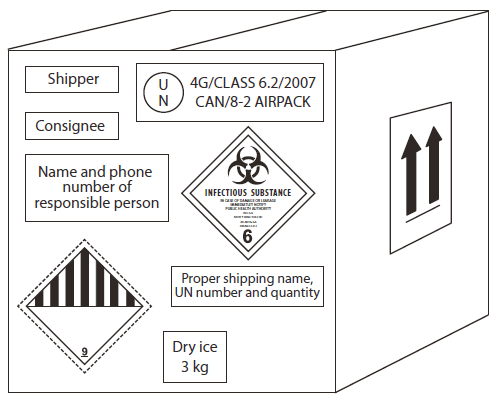Infectious substances, Category A
Definition / Classification
Category A infectious substances are human and animal pathogens which, when exposed, are capable of causing permanent disability, life-threatening or fatal disease in otherwise healthy humans and which are listed as Category A infectious substances (ADR 2.2.62.1.4.1 / IATA).
They include, but are not limited to:
- Cultures, patient specimens and liquid waste of all viruses of risk group 4
- Cultures of some viruses and bacteria of risk group 3 as listed in ADR / IATA.
- Pathogens and new or emerging infectious substances not listed as category A infectious substances, but which, when exposed, are nevertheless capable of causing permanent disability, life-threatening or fatal disease in otherwise healthy humans or animals.
Identification / UN number
- Infectious substance, affecting humans: UN 2814
- Infectious substance, affecting animals only: UN 2900
| UN-Number | Proper shipping name | Class | Packing instruction ADR | Bulk containers (ADR 7.3.2.6) | Packing instruction IATA |
|---|---|---|---|---|---|
| 2814 | Infectious substance, affecting humans | 6.2 | P620 | - | PI620 |
| 2814 | Infectious substance, affecting humans (in refrigerated liquid nitrogen) | 6.2 | P620 | - | PI620 |
| 2814 | Infectious substance, affecting humans (animal material only) | 6.2 | P620 | BK1 BK2 | PI620 |
| 2900 | Infectious substance, affecting animals only | 6.2 | P620 | - | PI620 |
| 2900 | Infectious substance, affecting animals only (in refrigerated liquid nitrogen) | 6.2 | P620 | - | PI620 |
| 2900 | Infectious substance, affecting animals only (animal material only) | 6.2 | P620 | BK1 BK2 | PI620 |
Packaging
Category A samples must be packed according to Packing Instruction P620 (ADR) or PI602 (IATA), respectively:
- Packaging instructions P620 for UN 2814 & 2900, ADR 4.1.4
- Packaging instructions PI602 (air), ICAO, Annex 18, technical instructions
Both packaging instructions require a triple packaging which has to be UN-certified.
Inner packagings:
- leak-proof primary receptacle(s), i.e. tubes, petri dishes, small bottles,
- leak-proof secondary packaging, i.e. plastic bottles, containers and
- - for liquids: absorbent material between primary receptacle and secondary packaging to fully absorb liquid in case of leak or breakage,
- - when multiple fragile primary receptacles are placed in a single secondary packaging, they are either individually wrapped or separated to prevent contact between them.
A rigid outer packaging, i.e. drums, boxes or jerricans with a smallest external dimension of minimal 100 mm.
For air transport only: the maximum net quantity per package is 50 ml or 50 g, respectively, without coolants.
Labelling and marking
- UN number and proper shipping name: UN 2814, infectious substance, affecting humans (description of content)
- Name and address of consigner and consignee, phone number of responsible person
- UN label for class 6.2., infectious substances
- If solid carbon dioxide is used: ‘Carbon dioxide, solid’, as coolant
Additionally for air transport:
- Net quantity
- Hazard labels: UN label for class 6.2., infectious substances, orientation arrows (when volume exceeds 50 ml)
- If solid carbon dioxide is used: ‘Carbon dioxide, solid’ as coolant, UN 1845, net quantity, class 9 hazard label
Transport documents
Dangerous goods transport document (ADR 5.4.1), including
- UN number: UN 2814 or UN 2900
- proper shipping name (infectious substance, affecting humans or infectious substances, infecting animals, respectively), scientific name in brackets
- hazard class 6.2
- total net quantity
- name and address of the consigner and the consignee
- name and phone number of a responsible person (ADR 5.4.1.2.4)
- Itemized list of contents between secondary packaging and outer packaging (ADR 4.1.8.3) For unknowns indicate: infectious substance affecting humans (suspected Category A infectious substance)
- Instructions for carrier what to do in case of an accident (instructions in writing, ADR 5.4.3)
- Delivery note/ (pro forma) invoice for customs
- Required permits.
Additionally for air transport:
- Shipper's declaration and
- Air Waybill (form provided and filled out by carrier)
- Cooling agents (pdf, 110 kb)
- Instructions in writing: Example of a Transport Emergency Card (TREM-Card) for UN2900, surface transport only. TREM Card French; TREM-Card German



